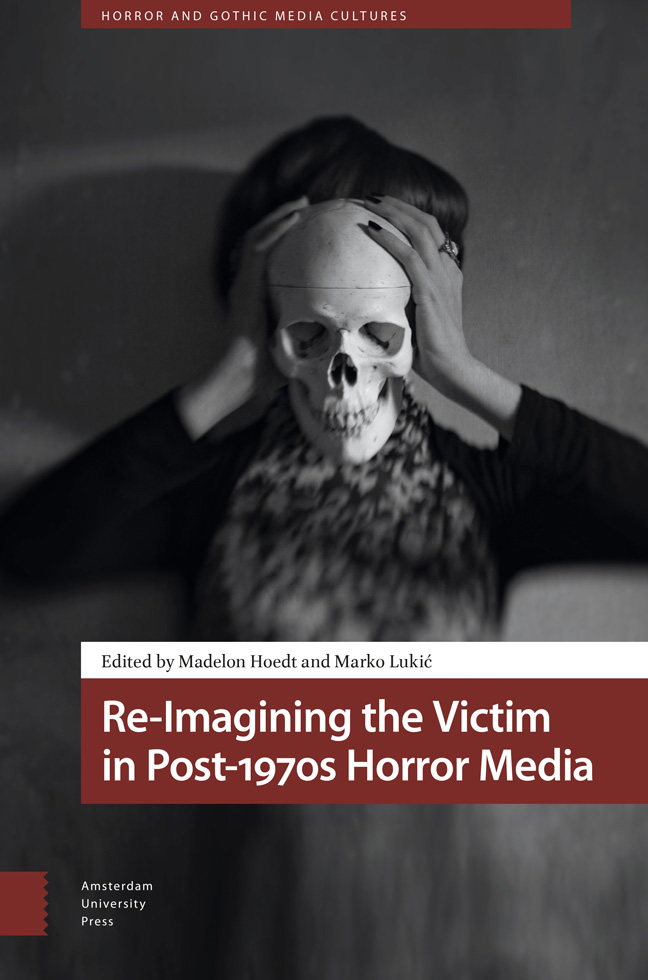Book contents
- Frontmatter
- Contents
- Introduction: Theorising the Victim
- 1 Opening the Gate: Reconfiguring the Child Victim in Stranger Things
- 2 Black Death: Black Victims in 1980s Teen Slashers
- 3 Beyond Binaries: The Position of the Transgender Victim in Horror Narratives
- 4 Through the Looking-Glass: The Gothic Victim in Jordan Peele’s Us
- 5 Postmortem Victimhood: Necrovalue in Phantasm and Dead and Buried
- 6 The Sad Killer: Perpetuating Spaces, Trauma and Violencewithin the Slasher Genre
- 7 “If this is the last thing you see… that means I died”: A Taxonomy of Camera-Operating Victims in Found Footage Horror Films
- 8 Victimhood and Rhetorical Dialectics within Clive Barker’s Faustian Fiction
- 9 Pain Index, Plain Suffering and Blood Measure: A Victimology of Driving Safety Films, 1955–1975
- 10 Biolithic Horror: Stone Victim/Victimisers in Resident Evil Village
- 11 The Potential Victim: Horror Role-Playing Games and the Cruelty of Things
- Bibliography
- Filmography
- Index
5 - Postmortem Victimhood: Necrovalue in Phantasm and Dead and Buried
Published online by Cambridge University Press: 26 March 2024
- Frontmatter
- Contents
- Introduction: Theorising the Victim
- 1 Opening the Gate: Reconfiguring the Child Victim in Stranger Things
- 2 Black Death: Black Victims in 1980s Teen Slashers
- 3 Beyond Binaries: The Position of the Transgender Victim in Horror Narratives
- 4 Through the Looking-Glass: The Gothic Victim in Jordan Peele’s Us
- 5 Postmortem Victimhood: Necrovalue in Phantasm and Dead and Buried
- 6 The Sad Killer: Perpetuating Spaces, Trauma and Violencewithin the Slasher Genre
- 7 “If this is the last thing you see… that means I died”: A Taxonomy of Camera-Operating Victims in Found Footage Horror Films
- 8 Victimhood and Rhetorical Dialectics within Clive Barker’s Faustian Fiction
- 9 Pain Index, Plain Suffering and Blood Measure: A Victimology of Driving Safety Films, 1955–1975
- 10 Biolithic Horror: Stone Victim/Victimisers in Resident Evil Village
- 11 The Potential Victim: Horror Role-Playing Games and the Cruelty of Things
- Bibliography
- Filmography
- Index
Summary
Abstract
Don Coscarelli’s Phantasm franchise and Gary Sherman’s Dead and Buried stage scenarios where the dead are brought back as undead labourers via embalming. This process is one of the technologies involving a postmortem condition in which the dead body is brought to life once again as an object. This new status as object pushes postmortem technologies towards capitalism, the latter based on processes of thingification where nature (including humans) is objectified to ensure exploitation. This chapter reads Phantasm II (1988) and Dead and Buried (1981) as examples of revictimisation, where necrotechnologies keep the bodies alive even when the victims scream for release and proper rest. As such, the films advocate for the rights of the postmortem subject amidst necropolitics.
Keywords: necropolitics, 1980s, capitalism, embalming, necrotechnologies, thingification
Capitalist ideology sustains the logic of labour-power, competition, accumulation, qualification and alienation. If the proletariat want money to get access to commodities, the market must be embraced, the whole working class becoming the victim of the continuing exploitation of wage labour. There is a “compelling parallel between a worker’s exploitation and alienation under capitalism and a victim’s exploitation and alienation at the market place,” since “workers must consider both the fruits of their labour and their labour itself as another man’s propriety” (Schwöbel-Patel 148). Not even retirement means the end of exploitation, as many senior people throughout the world must continue working to ensure economic survival after retirement from working at minimum wage. We came into this world to work, and only death stops the logic of being a cog in the machine of capitalism.
Horror fiction, however, can stage a scenario where the human continues labouring even after death, thus presenting a nightmarish version of the grand narrative of never-ending exploitation. Don Coscarelli’s Phantasm franchise (1979–98) revolves around a supernatural mortician known as the Tall Man (Angus Scrimm) who kills and reanimates the dead as his misshapen slaves. The films establish a mythology in which human corpses must work for the Tall Man as a labour force. Gary Sherman’s Dead and Buried (1981), opening just two years after the first Phantasm, stages a similar premise.
- Type
- Chapter
- Information
- Re-Imagining the Victim in Post-1970s Horror Media , pp. 95 - 112Publisher: Amsterdam University PressPrint publication year: 2024

